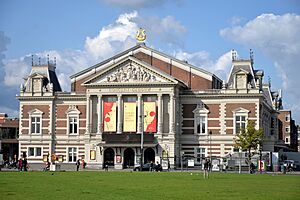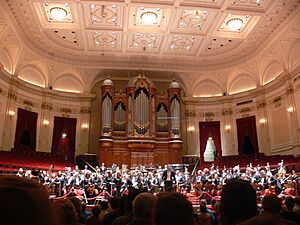Royal Concertgebouw Orchestra facts for kids
Quick facts for kids Royal Concertgebouw Orchestra |
|
|---|---|
| Orchestra | |
 |
|
| Founded | 1888 |
| Location | Amsterdam, Netherlands |
| Concert hall | Royal Concertgebouw |
| Principal conductor | Klaus Mäkelä (designate, effective 2027) |
The Royal Concertgebouw Orchestra is a famous Dutch symphony orchestra. It was started in 1888 in Amsterdam, Netherlands. Many people think it is one of the best orchestras in the world.
It was first called the Concertgebouw Orchestra. In 1988, Queen Beatrix gave it the "Royal" title. This was to celebrate its 100th birthday! The concert hall where they play also got the "Royal" title in 2013.
Contents
History of the Orchestra
The Concertgebouw concert hall opened on April 11, 1888. The orchestra was formed a few months later. They played their first concert there on November 3, 1888. Willem Kes was their first chief conductor.
Early Years: 1888–1945
Willem Kes led the orchestra from 1888 to 1895. In 1895, Willem Mengelberg became the chief conductor. He stayed in this job for 50 years! That's a very long time for a music director.
Mengelberg helped the orchestra become famous around the world. He especially liked playing music by composers like Gustav Mahler and Richard Strauss.
For about 75 years, the orchestra had many different conductors. Besides the chief conductor, there were "first conductors" and "second conductors." First conductors helped with planning the music. Second conductors followed instructions.
During Mengelberg's time, famous "first conductors" included Karl Muck, Pierre Monteux, Bruno Walter, and Eugen Jochum. These conductors were also respected around the world. Dutch musicians like Cornelis Dopper and Eduard van Beinum were "second conductors."
In 1945, Mengelberg was removed as chief conductor. This was because of his actions during World War II. He was not allowed to conduct in the Netherlands again. He passed away in 1951 and never led the orchestra after 1945.
After the War: 1945–1988
From 1945 to 1959, Eduard van Beinum was the orchestra's main conductor. He first performed with them in 1929. He became a second conductor in 1931 and a co-principal conductor in 1938.
Van Beinum was known for playing the symphonies of Anton Bruckner. He made recordings of Bruckner's music. Van Beinum was the only chief conductor after World War II. He sadly passed away suddenly in April 1959 while on the Concertgebouw stage.
Bernard Haitink first conducted the orchestra on November 7, 1956. After Van Beinum's death, Haitink and Eugen Jochum shared the chief conductor role from 1961 to 1963. Haitink then became the only chief conductor in 1963. He stayed in this role until 1988.
Under Haitink, the orchestra made many recordings. They recorded for companies like Philips Records, EMI, and Columbia Records. In the early 1980s, the Dutch government planned to cut funding for the orchestra. This could have meant losing musicians. Haitink said he would resign if this happened, and the money problems were solved.
Haitink was later named the orchestra's conductor laureate. This is an honorary title. He kept this title until he retired in 2019 and passed away in 2021.
Modern Era: 1988–Present
Riccardo Chailly first conducted the orchestra in 1985. He was chosen to be the next chief conductor after Haitink. Chailly was the first non-Dutch person to hold this important job. He was chief conductor from 1988 to 2004.
Chailly recorded all the symphonies by Mahler and Brahms with the orchestra. He also liked to play modern music. After he left in 2004, Chailly was named Conductor Emeritus.
Mariss Jansons first conducted the orchestra in 1988. In 2002, the orchestra chose Jansons as its next chief conductor. His time officially began on September 1, 2004. He led the orchestra until the 2014–15 season. Jansons also held the title of conductor emeritus until he passed away in 2019.
Daniele Gatti first guest-conducted the orchestra in 2004. In October 2014, he was named the seventh chief conductor. His role started in 2016. On August 2, 2018, the orchestra ended Gatti's time as chief conductor. This was due to concerns about his conduct.
In October 2020, the orchestra announced that Iván Fischer would be an honorary guest conductor. This role started with the 2021–2022 season.
Klaus Mäkelä first guest-conducted the orchestra in September 2020. He conducted them several more times. In June 2022, the orchestra announced that Mäkelä would be an artistic partner from 2022 to 2027. He will then become their next chief conductor, starting with the 2027–2028 season. His first contract will be for five years.
In March 2024, the orchestra created the "Bernard Haitink Associate Conductorship." This was made possible by a donation from Patricia Haitink and her family. Aurel Dawidiuk was named the first associate conductor under this program.
What Makes the Orchestra Special?
The orchestra had a special connection with Gustav Mahler. They often played his symphonies. In 1920, they even held a festival just for his music. Other conductors who worked closely with the orchestra include Pierre Monteux, Eugen Jochum, George Szell, and Kirill Kondrashin.
Another special thing about the Royal Concertgebouw Orchestra is that it has had only nine chief conductors in its long history. This is different from other orchestras of its age. The orchestra has also made almost a thousand recordings! These recordings have helped build its great reputation. The orchestra also plays for opera shows at the Dutch National Opera.
The orchestra has its own music label called RCO Live. They have released CDs conducted by Jansons and Haitink, among others.
Chief Conductors
- Willem Kes (1888–1895)
- Willem Mengelberg (1895–1945)
- Eduard van Beinum (1945–1959)
- Eugen Jochum (1961–1963; co-chief conductor with Bernard Haitink)
- Bernard Haitink (1961–1988)
- Riccardo Chailly (1988–2004)
- Mariss Jansons (2004–2015)
- Daniele Gatti (2016–2018)
- Klaus Mäkelä (designate, effective 2027)
See also
 In Spanish: Orquesta Real del Concertgebouw para niños
In Spanish: Orquesta Real del Concertgebouw para niños



